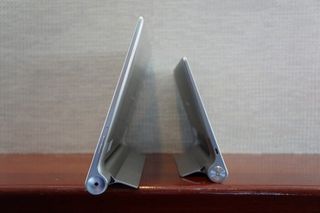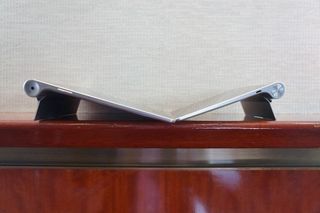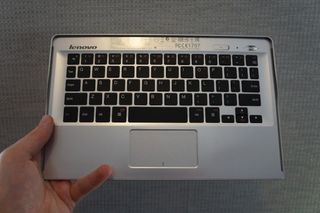Lenovo Yoga Tablets Hands-on: 3 Modes, 18-Hour Battery, From $249
The Surface isn't the only tablet with a built-in stand. Say hello to Lenovo's new Android-powered Yoga Tablets. On sale Oct. 30, these tablets come in an 8-inch version ($249 at Best Buy) and a 10-inch flavor ($299 at most major retailers). While these slates sport mid-range specs--quad-core MediaTek CPUs, 1GB RAM, 1280 x 800 displays--they literally stand out with built-in kickstands that support three use modes and a rated 18 hours of battery life.
We spent some hands-on time with both tablets and found them to be quite versatile for the price.
Battery Life
How can a slate get so much power out of a single charge? By using a unique cylindrical battery pack that houses two laptop-grade batteries. The Yoga Tablet 8 offers a massive 6,000 mAh battery, while the Yoga Tablet 10 comes with an even bigger 9,000 mAh pack.
MORE: Top 10 Tablets

Design
The eye-catching design begins with the battery on its wide bottom edge that tappers off to a point along the top edge. It's as if Lenovo took the folding design from Sony's older Tablet S and actually did something useful with the side with the extra girth.
Measuring 8.4 x 5.7 x 0.12-0.29 inches and weighing 14.1 ounces, the Yoga Tablet 8 is larger and heavier than the iPad mini with Retina display (7.9 x 5.3 x 0.29 inches, 11.7 ounces). The Yoga Tablet 10, alternatively, measures 10.3 x 7.1 x 0.12-0.32 inches and weighs 1.33 pounds, which is both larger and heavier than the Samsung Galaxy Tab 3 (10.1 9.6 x 6.9 x 0.31 inches, 1.12 pounds). The good news is that holding the Yoga Tablets felt fairly comfortable because of the way the weight is distributed.

Three Modes
When used in Hold mode, the Yoga Tablet's rounded battery pack makes the slate resemble a folded magazine and is comfortable to grip. Want to watch a movie on the Yoga? Use Stand mode by pulling down the stand to prop up the slate and adjust its viewing angle to your liking. Tilt mode lets you lay the tablet on its back with the kickstand out, which makes using the slate on a flat surface while typing or browsing the Web more ergonomic than on a traditional tablet.
Stay in the know with Laptop Mag
Get our in-depth reviews, helpful tips, great deals, and the biggest news stories delivered to your inbox.
The Yoga Tablet's different modes don't just make using the tablet easier, they also provide specific benefits for each use case scenario. For instance, the Smart Slide Bar, accessible by swiping in from the left side of the screen in Hold mode and right side in Stand and Tilt modes, gives you the option to quickly access the most likely apps you are going to use in each mode.
Another perk: the screen gets brighter when you go from Hold to Stand mode, which makes sense since you might be watching a movie or looking up a recipe from a bit further away.

In Hold mode, for example, the Smart Slide Bar provides you with a large e-reader app box, which you can browse to find your favorite book or magazine. In Stand and Tilt mode, however, the Smart Slide Bar gives you a large video box, from which you can watch natively stored movies. Below the book and movie boxes are lists of your most frequently used apps. Below those are manual buttons for switching between the slate's three use modes.
Specs and Early Benchmarks
From a performance perspective, the Yoga Tablet 8 and Yoga Tablet 10 are complete equals. Both slates sport relatively low-res 1280 x 800-pixel displays and include the same 1.2-GHz quad-core MediaTek MT8125 processors and 1GB of RAM. Internal storage is rated at 16GB, though that can be augmented via the available microSD card slot situated behind the slates' kickstands.
Both slates also offer 5-megapixel rear cameras and 1.6-megapixel front cameras, as well as dual front-mounted Dolby Digital Plus DS1 speakers situated directly below their displays.
On the Quadrant benchmark test, the Yoga Tablet 8 scored 4,861. The $149 ASUS MeMO Pad HD 7, with its quad-core MediaTek processor and 1GB of RAM, scored a slightly lower 3,414. The $229 Nvidia Tegra 4-powered Google Nexus 7 notched 4,949. On the 3DMark Ice Storm Extreme graphics test, the Yoga Tablet 8 hit 1,559. The ASUS slate came in with 1,556, while the Nexus 7 scored a much more impressive 7,061.
For its part, the Yoga Tablet 10 scored 4,735 on the Quadrant test. Its nearest competitor, the $279 ASUS MeMO Pad FHD 10, scored a slightly lower 3,414. That tablet has an Intel Atom Clover Trail processor. The Yoga Tablet 10 also scored 1,507 on the 3DMark Ice Storm Extreme graphics test.
Accessories
If typing on a touch screen isn't your style, Lenovo is also selling a Bluetooth Keyboard Cover for the Yoga 10 for $69. Lenovo says the cover will also put the tablet to sleep and wake it up when taken off. The 8-inch model doesn't get a keyboard.

Outlook
Lenovo is looking for a hit in the the mid-range market with the Yoga Tablet 8 and Yoga Tablet 10. And based on what we've seen, these are some fairly slick slates. While the specs don't wow, the estimated 18 hours of battery life and unique stand feature make these devices very intriguing. Stay tuned for full reviews of both tablets.
